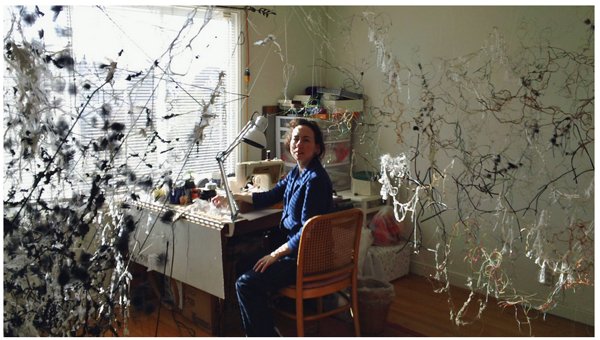“I start a new piece by looking at materials
and holding them in my hands.”
by Emily Jaeger, Features Editor

Holly Wong is an artist who lives and works in San Francisco, California. She studied at the San Francisco Art Institute where she graduated with a Master of Fine Arts with a concentration in New Genres. Wong creates installations, mixed media projects, and works on paper. For the past twenty years, Wong has worked in a variety of mediums and approaches including painting, photography, textiles, video, and performance.
The painter Philip Guston is now a regular on the list of many artists’ influences and inspirations, though it is unclear how many would truly push themselves to follow his challenging artistic path. After working in abstract impressionism, or his preferred term, “New York School,” for the first twenty years of his very successful career, Guston grew frustrated with the abstract and returned to representational painting. While this abrupt change in style was initially panned by critics, Guston’s re-examination of his artistic practice is now regarded as a rejection of complacency and an ultimate act of artistic freedom. Holly Wong, whose installations are featured in May’s issue, has indeed followed a similarly harrowing path in her work, not only transitioning from the figurative to the abstract but also transitioning between genres.

After twenty years of producing figurative drawings and paintings exploring feminist and social justice initiatives, Wong decided to turn inward: “I needed to turn the lens towards myself—how I processed things emotionally and spiritually in my own life. I could no longer work in a representational way because I found that feelings or psychological states were far more ephemeral. I started to work in an intuitive way, letting the material ultimately lead me along in the direction it wanted to go.”

The resulting installations—made from found materials such as thread, paper, and netted produce bags—seem to float on the air. Wong says that unlike paint, manufactured expressly for artistic use, she found herself connecting on a deeper level to found materials, the residues of her everyday life: “humble things that we use in our lives have a personal and approachable feeling that allows me the freedom to work with them in painting and sculptural ways without getting trapped in the history of the material.”

Delicate found materials can present structural challenges, but Wong perceives these hiccups as part of her partnership with the materials: “You have to let go of the notion that the installation is a fixed monolith and that if you put something in a certain place, it will behave a certain way. The materials often age or decay over time which becomes part of the work.” For example, in “Constellation,” Wong found that the weight of gauze constructions suspended from the ceiling caused the entire installation to sag. Rather than reinforcing the materials, she refocused, crafting the sagging intentionally and making gravity become a fundamental theme.

Although Wong has transitioned from the political to emotional in her work, sewing thread serves as a double homage, the tie that binds her personal explorations to larger themes. Her mother worked as a seamstress and, growing up, Wong remembers “the presence of a sewing machine was always a positive and comforting force in my life.” Wong does not claim to have any “practical” sewing skills; however, she recalls her mother’s profession in her own installations, using the sewing machine to create wandering lines that connect disparate materials together: “I believe the sewing line is an interconnecting force that meanders throughout all my works. It is that constant connection which is both delicate and very strong at the same time.”

The second homage in Wong’s use of thread in her work is to feminist artists such as Tara Donovan, Monika Grzymala, Sheila Hicks, Judy Pfaaf, and Miriam Schapiro, who have re-examined traditional practices like weaving, sewing, and decoration in a transformative way. Here, too, the delicate, ephemeral quality of Wong’s floating sculptures takes on the strength and power imbued in the reclamation of “women’s crafts.”
Part of Wong’s mastery stems from a deep understanding of her own process and a willingness to experiment. Like Guston, her installations represent a type of freedom—from what is expected and from what feels comfortable. And Wong wholeheartedly encourages other artists to follow suite and take risks in their work: “the best advice I can give to other artists is to be reassured that within each of us is a unique story and our work really flourishes when we finally have the courage to tell that story without fear of failure.”
Copyright 2017 Woven Tale Press LLC. All Rights Reserved.

